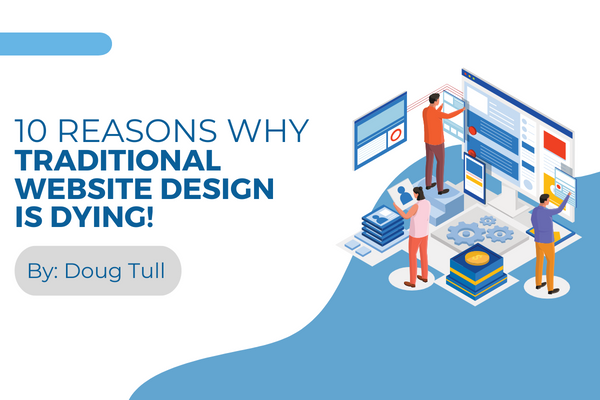The majority of websites are dead before they even launch. This is the sad reality that countless businesses face, and most don’t even realize it until it’s too late–after they’ve wasted thousands of hours and thousands of dollars on a website that was poorly planned, poorly designed, poorly executed, and built on a flawed foundation and process. Moreover, it took months or even years to go live, and their staff still has no idea how to maintain, modify or grow it.
When their websites reside on page 570 of Google, their phones aren’t ringing, their stores are empty, and their company’s bottom line shrinks, do they finally realize that their website is useless, or worse yet, a liability?
The Secrets To Successful Website Design, And There’s Proof
In our work at Intuitive Websites, we hear the horror stories of website design and development projects. In fact, this happens so often it is now safe to say traditional website design and development is broken and must be declared dead!
The good news is we have a solution and a plan to get your website live and working for your company. We will start with a look at what’s broken.
A Flood of New Websites
A recent study showed that an average of 252,000 websites go live daily. That’s every day. And the majority of the websites that go live have not had their content proofed or functionality tested, thus rushing a poorly-designed, poorly-coded, content-starved, malfunctioning website to market, often just to meet some artificial deadline.
As you might have guessed, each of these new websites seeks to rank and reach the first page of Google for competitive, popular and valuable keyword searches from prospective customers and website visitors. With this kind of competition, what chance does your website have of ranking and finding your audience? Moreover, what if your website sucks? And by sucks, we mean your website was poorly-designed, lacks great content, has poor coding, has no discernible CTA, isn’t mobile friendly, and was thrown together with no vision or strategy for success, structure, or compelling promise.
Why do so many website projects go wrong?
Here are the top ten reasons.
Reason #1: No plan. No vision. The build-it-and-they’ll-come myth persists.
It turns out it’s not that hard to churn out and throw together a mediocre site. It’s been the norm for years. Even in the days of the late 1990s, when having a website was a novelty, this approach was never a winning one.
Your website is important. If you wing it, you will not succeed. A lack of planning, a clear vision, misalignment, or missing alignment with the company’s brand and overall marketing strategy is precisely what will cause your website to fall short of reaching goals.
Think about your website as your best salesperson, marketing team, commercial, 24-7 rainmaker, and global billboard. A great website can make your company, and a mediocre one can end it.
Reason #2: It’s About Your Customers, Not You
When designing a new website, you must think of your users first.
Here are a few questions to ask:
-
How do you solve their problems?
-
How do you help them get what they want?
-
What must they believe within seconds of landing on your website?
-
What do you want them to do?
-
How do you want them to think or feel?
-
Who is your ideal customer?
-
What do you offer that no one else can?
Answering these questions, and many more, helps you form a strategy. With a plan built on research, asking the right questions, and thinking about things from your customer’s point of view, you are taking the most critical and essential step to ensure your website’s success. Knowing these things will help you develop and deliver the other important elements.
Reason #3: Too Many Cooks and No Head Chef
A new website build project without a captain is like a ship without oars, sails, or no navigation. As with any important task, someone has to steer the ship. The buck must stop somewhere. If not, you will do a website in one of the worst ways possible, by a committee, and thrown together with conflicting ideas and content. And, even when there is a project lead, if he or she is still embracing the old, failed way of doing things, you’ll still end up with poor results and a website that doesn’t accomplish any of your goals. You must have a plan, leadership, and project management to succeed. As you may have guessed, far too many website projects lack any kind of direction or quality control.
Reason #4: Weak, Unoriginal, Unfocused, Unimaginative Content and Design
Your content–copy, graphics, design, etc. must dazzle, enthrall, entice, and capture the user’s attention, trust, and interest. Unfortunately, simply cutting and pasting copy from a competitor’s site, failing to execute proper keyword research, writing amateurish, uninspired copy, using clip art, photo stock, and a confused, illogical design and navigation can all add up to what’s known as a “bounce.” A bounce is when a user finally lands on your site and isn’t captured or interested enough to stay, learn more, and take action. With more and more users coming from mobile devices and being in a hurry, your site cannot afford to lose these valuable visitors.
Reason #5: Poor Website Coding
Coding is what makes a website function. It’s the brain and lifeblood of every site. If you don’t hire the right programmers and use the right coding approach, you can end up with a mess and a site that you cannot easily update, modify, or use.
Worse yet, poor coding might lead to your site crashing often and make it more vulnerable to hacking. A great website delivers a great user experience, has intuitive navigation, a high degree of functionality, and is robust and optimized for search (SEO). Some website designers and developers use arcane coding methods that are not easy for the client to use, understand or grow.
Reason #6: What Does The User Do? No Call To Action
A website must be intuitive and easy to navigate, and the user must quickly understand what action they need to take. If your website is not well-planned and you haven’t defined your customer and your own unique sales proposition, it’s hard to expect new users and prospects to know what you offer or what action they are to take to solve their problems or meet their needs. Great websites convert browsers into prospects and customers.
Reason #7: Don’t Forget About Mobile Users
The mighty Google, the search engine that holds over 96% of the search market, has shown that mobile search now accounts for 63% of overall search volume. It’s not enough to have a good-looking website that looks great on your giant monitor; your site has to load rapidly and look great on the small screen in your customer’s hands. Every new website must now design for the mobile experience; if your site is older, it may be time for a redesign.
Reason #8: Not Measuring Success and Defining It
To know if you’re winning, you must have objectives that can be measured, tested, refined, and acted upon. When you have objectives and measure them, you’re not stumbling in the dark. Data, measurements, and actions based on these KPIs will help you get the most out of your website.
Reason #9: Not Baking In SEO On The Front End
SEO or Search Engine Optimization, the process of “optimizing” your website, should begin in the earliest planning stages. Savvy marketers know that robust keyword research, proper meta tagging, site architecture, URL structure, and paying attention to the technical aspects of website optimization should occur in the beginning stages and continue throughout the lifetime of your website.
Smart optimization from the beginning produces optimal results, helps your site rank faster, bolsters your paid media efforts (Google Ads), and helps make your pages relevant to profitable, valuable search queries from your best prospects.
Reason #10: The Perfect Website Is The Enemy of The Great Website
While it’s obviously essential to develop and launch a great website, many companies delay the launch of their websites because they believe their websites have to be perfect to go live. Endless committees, meetings, and revisions can delay your site’s launch and paralyze your marketing efforts.
These delays prevent you from gathering data, refining your approach, and getting to market rapidly. A website of 50 pages or more is typically not built all upfront; it is built on a foundation and with a process. A great website is a living, breathing thing that continues to grow and improve.
There’s A Better Way, And It Works
So, what is the proven, effective approach to creating a website that ranks in search, attracts your best prospects, delivers a great user experience, and turns your website browsers into buyers and raving fans?
What’s the big secret, and does it live up to the hype?
DRUM ROLL….
Growth-Driven Design
Growth-Driven Design (GDD) is a proven strategy that utilizes and maximizes lean agile principles, rapid iteration, and planning to produce measurable results and growth more rapidly than failed traditional, unfocused, non-data-driven approaches. GDD is a web design method that delivers rapid results and growth and eliminates launch delays.
There are three Growth-Design phases or steps–1. Strategy 2. Launchpad site launch 3. Continuous improvement. These methods are proven to save you money on the front end, get a site to “market” faster, and start reaching your best prospects immediately.
Instead of spending hundreds of hours of work and preparation without launching or producing any results, you launch a smaller site faster, with less hassle, and then refine and improve the launchpad site in sprints.
There’s more to GDD than described above, but these are the core concepts and practices.
Stop wasting time on the old, failed ways of traditional web design that lead to major delays, headaches, endless revisions, and major costs. Instead, it’s time to get smart and nimble, and do websites the right way, the proven way.
Intuitive Websites has embraced and mastered Growth-Driven Design and has transformed our client’s web presence and websites into lead-generation growth machines.
Discover how our mastery of GDD can make your organization into a lead and sales generation machine.




